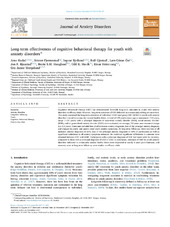| dc.contributor.author | Kodal, Arne | en_US |
| dc.contributor.author | Fjermestad, Krister | en_US |
| dc.contributor.author | Bjelland, Ingvar | en_US |
| dc.contributor.author | Gjestad, Rolf | en_US |
| dc.contributor.author | Øst, Lars Gøran | en_US |
| dc.contributor.author | Bjåstad, Jon Fauskanger | en_US |
| dc.contributor.author | Haugland, Bente Storm Mowatt | en_US |
| dc.contributor.author | Havik, Odd E. | en_US |
| dc.contributor.author | Heiervang, Einar | en_US |
| dc.contributor.author | Wergeland, Gro Janne | en_US |
| dc.date.accessioned | 2018-09-10T12:00:49Z | |
| dc.date.available | 2018-09-10T12:00:49Z | |
| dc.date.issued | 2018-01 | |
| dc.identifier.issn | 0887-6185 | |
| dc.identifier.uri | https://hdl.handle.net/1956/18449 | |
| dc.description.abstract | Cognitive behavioral therapy (CBT) has demonstrated favorable long-term outcomes in youth with anxiety disorders in efficacy trials. However, long-term outcomes of CBT delivered in a community setting are uncertain. This study examined the long-term outcomes of individual (ICBT) and group CBT (GCBT) in youth with anxiety disorders treated in community mental health clinics. A total of 139 youth (mean age at assessment 15.5 years, range 11–21 years) with a principal diagnosis of separation anxiety disorder (SAD), social anxiety disorder (SOP), and/or generalized anxiety disorder (GAD) were evaluated, on average, 3.9 years post-treatment (range 2.2–5.9 years). Outcomes included loss of all inclusion anxiety diagnoses, loss of the principal anxiety diagnosis and changes in youth- and parent-rated youth anxiety symptoms. At long-term follow-up, there was loss of all inclusion anxiety diagnoses in 53%, loss of the principal anxiety diagnosis in 63% of participants as well as significant reductions in all anxiety symptom measures. No statistical significant differences in outcome were obtained between ICBT and GCBT. Participants with a principal diagnosis of SOP had lower odds for recovery, compared to those with a principal diagnosis of SAD or GAD. In conclusion, outcomes of CBT for youth anxiety disorders delivered in community mental health clinics were improved at nearly 4 years post-treatment, and recovery rates at long-term follow-up were similar to efficacy trials. | en_US |
| dc.language.iso | eng | eng |
| dc.publisher | Elsevier | eng |
| dc.relation.ispartof | <a href="http://hdl.handle.net/1956/18450" target="_blank">Long-term effectiveness of cognitive behavior therapy for youth with anxiety disorders: Outcome, predictors and social anxiety</a> | |
| dc.rights | Attribution CC BY-NC-ND | eng |
| dc.rights.uri | http://creativecommons.org/licenses/by-nc-nd/4.0/ | eng |
| dc.subject | Anxiety disorders | eng |
| dc.subject | Long-term follow-up | eng |
| dc.subject | Youth | eng |
| dc.subject | Cognitive behavioral therapy | eng |
| dc.subject | Community clinic | eng |
| dc.title | Long-term effectiveness of cognitive behavioral therapy for youth with anxiety disorders | en_US |
| dc.type | Peer reviewed | |
| dc.type | Journal article | |
| dc.description.version | publishedVersion | en_US |
| dc.rights.holder | Copyright 2017 The Author(s) | |
| dc.identifier.doi | https://doi.org/10.1016/j.janxdis.2017.11.003 | |
| dc.identifier.cristin | 1524350 | |
| dc.source.journal | Journal of Anxiety Disorders | |
| dc.source.40 | 53 | |
| dc.source.pagenumber | 58-67 | |

